MERCEDES-BENZ B-CLASS 2012 Workshop Manual
Manufacturer: MERCEDES-BENZ, Model Year: 2012, Model line: B-CLASS, Model: MERCEDES-BENZ B-CLASS 2012Pages: 340, PDF Size: 3.09 MB
Page 51 of 340
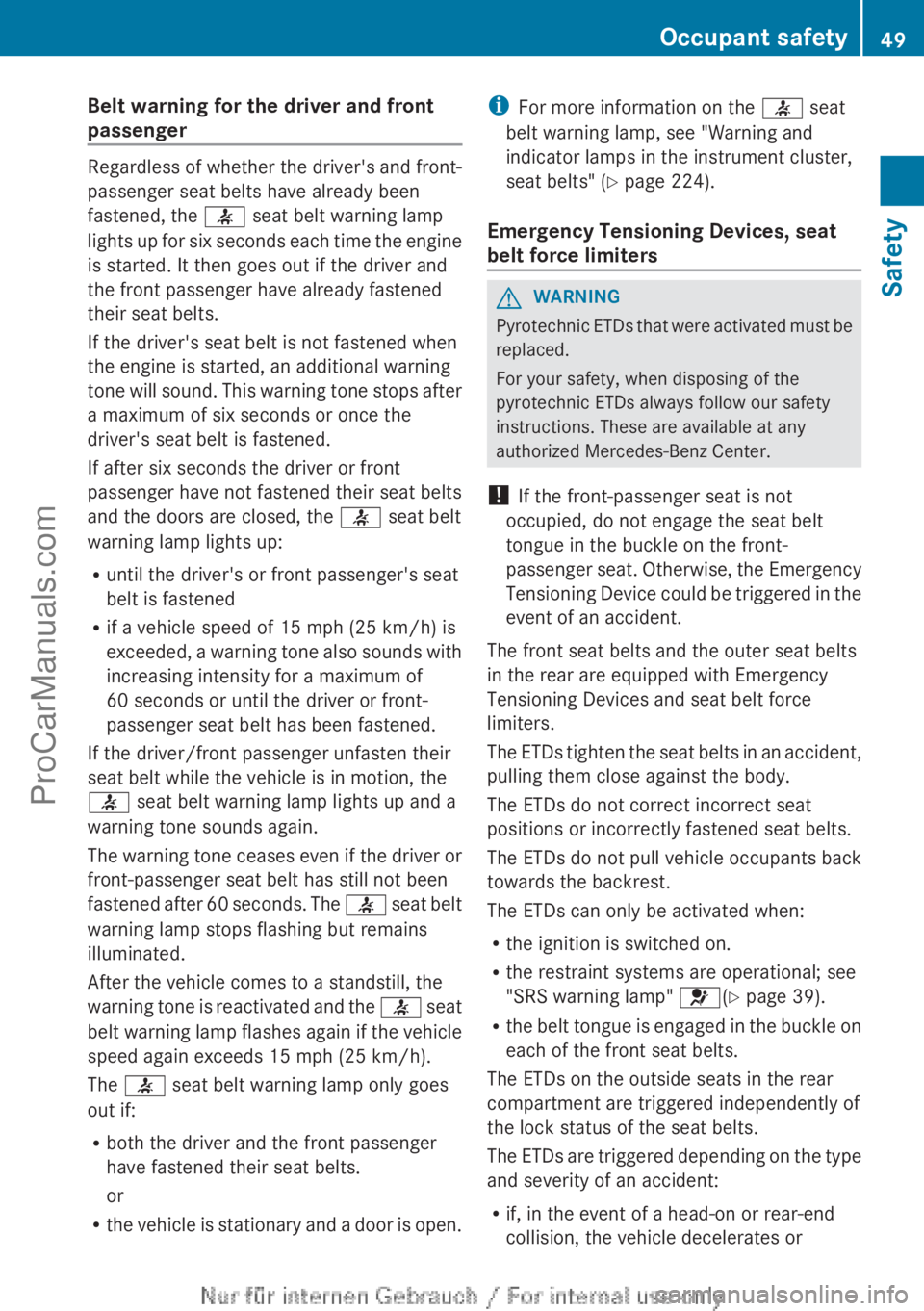
Belt warning for the driver and front
passenger
Regardless of whether the driver's and front-
passenger seat belts have already been
fastened, the 7 seat belt warning lamp
lights up
for
six seconds each time the engine
is started. It then goes out if the driver and
the front passenger have already fastened
their seat belts.
If the driver's seat belt is not fastened when
the engine is started, an additional warning
tone will sound. This warning tone stops after
a maximum of six seconds or once the
driver's seat belt is fastened.
If after six seconds the driver or front
passenger have not fastened their seat belts
and the doors are closed, the 7 seat belt
warning lamp lights up:
R until the driver's or front passenger's seat
belt is fastened
R if a vehicle speed of 15 mph (25 km/h) is
exceeded, a warning tone also sounds with
increasing intensity for a maximum of
60 seconds or until the driver or front-
passenger seat belt has been fastened.
If the driver/front passenger unfasten their
seat belt while the vehicle is in motion, the
7 seat belt warning lamp lights up and a
warning tone sounds again.
The warning tone ceases even if the driver or
front-passenger seat belt has still not been
fastened after 60 seconds. The 7 seat belt
warning lamp stops flashing but remains
illuminated.
After the vehicle comes to a standstill, the
warning tone is reactivated and the 7 seat
belt warning lamp flashes again if the vehicle
speed again exceeds 15 mph (25 km/h).
The 7 seat belt warning lamp only goes
out if:
R both the driver and the front passenger
have fastened their seat belts.
or
R the vehicle is stationary and a door is open. i
For more information on the 7 seat
belt warning lamp, see "Warning and
indicator lamps in the instrument cluster,
seat belts" ( Y page 224).
Emergency Tensioning Devices, seat
belt force limiters G
WARNING
Pyrotechnic ETDs that were activated must be
replaced.
For your safety, when disposing of the
pyrotechnic ETDs always follow our safety
instructions. These are available at any
authorized Mercedes-Benz Center.
! If the front-passenger seat is not
occupied, do not engage the seat belt
tongue in the buckle on the front-
passenger seat. Otherwise,
the Emergency
Tensioning Device could be triggered in the
event of an accident.
The front seat belts and the outer seat belts
in the rear are equipped with Emergency
Tensioning Devices and seat belt force
limiters.
The ETDs tighten the seat belts in an accident,
pulling them close against the body.
The ETDs do not correct incorrect seat
positions or incorrectly fastened seat belts.
The ETDs do not pull vehicle occupants back
towards the backrest.
The ETDs can only be activated when:
R the ignition is switched on.
R the restraint systems are operational; see
"SRS warning lamp" 6(Y page 39).
R the belt tongue is engaged in the buckle on
each of the front seat belts.
The ETDs on the outside seats in the rear
compartment are triggered independently of
the lock status of the seat belts.
The ETDs are triggered depending on the type
and severity of an accident:
R if, in the event of a head-on or rear-end
collision, the vehicle decelerates or Occupant safety
49
Safety Z
ProCarManuals.com
Page 52 of 340
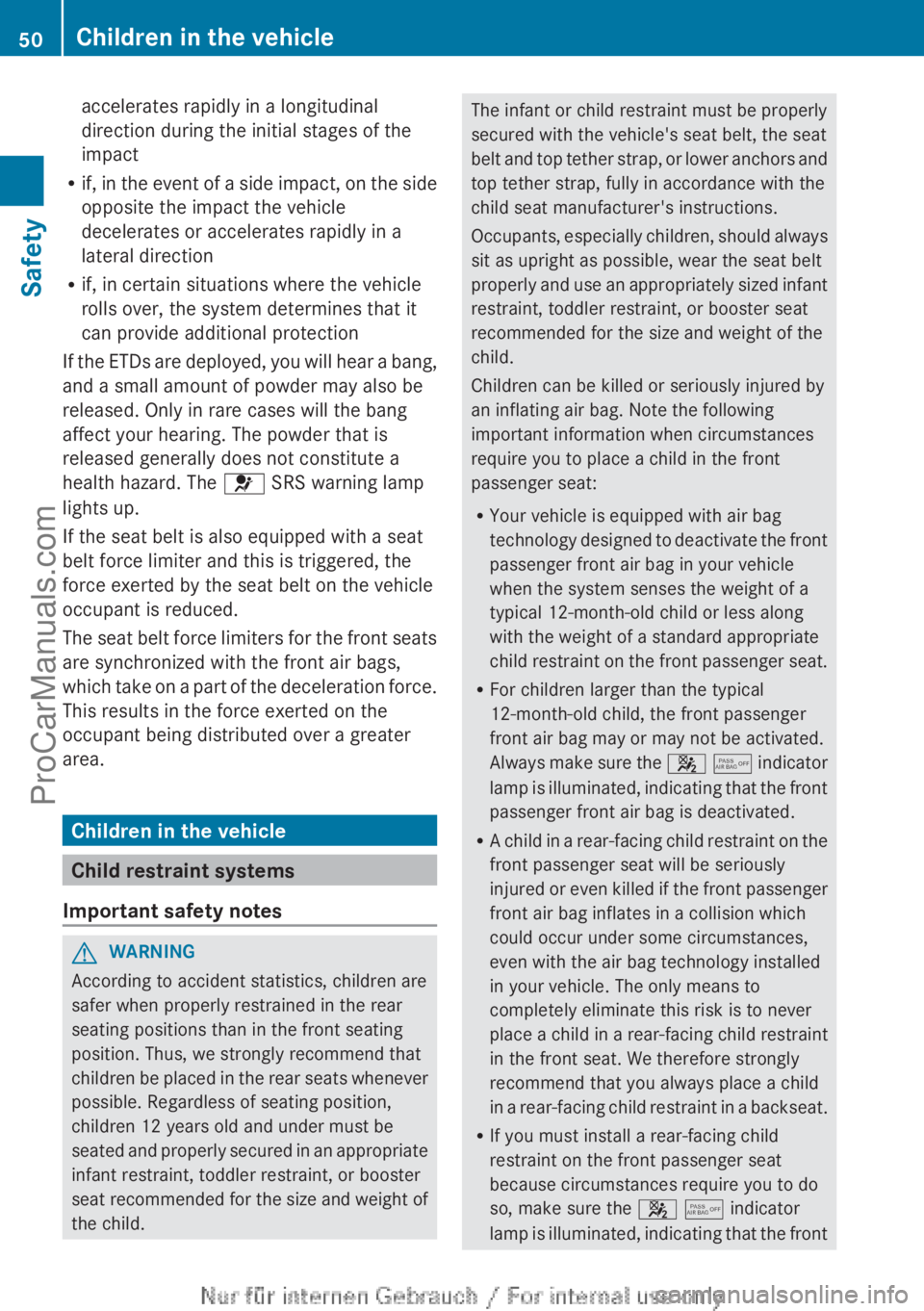
accelerates rapidly in a longitudinal
direction during the initial stages of the
impact
R if, in the
event of a side impact, on the side
opposite the impact the vehicle
decelerates or accelerates rapidly in a
lateral direction
R if, in certain situations where the vehicle
rolls over, the system determines that it
can provide additional protection
If the ETDs are deployed, you will hear a bang,
and a small amount of powder may also be
released. Only in rare cases will the bang
affect your hearing. The powder that is
released generally does not constitute a
health hazard. The 6 SRS warning lamp
lights up.
If the seat belt is also equipped with a seat
belt force limiter and this is triggered, the
force exerted by the seat belt on the vehicle
occupant is reduced.
The seat belt force limiters for the front seats
are synchronized with the front air bags,
which take on a part of the deceleration force.
This results in the force exerted on the
occupant being distributed over a greater
area. Children in the vehicle
Child restraint systems
Important safety notes G
WARNING
According to accident statistics, children are
safer when properly restrained in the rear
seating positions than in the front seating
position. Thus, we strongly recommend that
children be placed
in the rear seats whenever
possible. Regardless of seating position,
children 12 years old and under must be
seated and properly secured in an appropriate
infant restraint, toddler restraint, or booster
seat recommended for the size and weight of
the child. The infant or child restraint must be properly
secured with the vehicle's seat belt, the seat
belt and
top
tether strap, or lower anchors and
top tether strap, fully in accordance with the
child seat manufacturer's instructions.
Occupants, especially children, should always
sit as upright as possible, wear the seat belt
properly and use an appropriately sized infant
restraint, toddler restraint, or booster seat
recommended for the size and weight of the
child.
Children can be killed or seriously injured by
an inflating air bag. Note the following
important information when circumstances
require you to place a child in the front
passenger seat:
R Your vehicle is equipped with air bag
technology designed to deactivate the front
passenger front air bag in your vehicle
when the system senses the weight of a
typical 12-month-old child or less along
with the weight of a standard appropriate
child restraint on the front passenger seat.
R For children larger than the typical
12-month-old child, the front passenger
front air bag may or may not be activated.
Always make sure the 4 5 indicator
lamp is illuminated, indicating that the front
passenger front air bag is deactivated.
R A child in a rear-facing child restraint on the
front passenger seat will be seriously
injured or even killed if the front passenger
front air bag inflates in a collision which
could occur under some circumstances,
even with the air bag technology installed
in your vehicle. The only means to
completely eliminate this risk is to never
place a child in a rear-facing child restraint
in the front seat. We therefore strongly
recommend that you always place a child
in a rear-facing child restraint in a backseat.
R If you must install a rear-facing child
restraint on the front passenger seat
because circumstances require you to do
so, make sure the 4 5 indicator
lamp is illuminated, indicating that the front 50
Children in the vehicle
Safety
ProCarManuals.com
Page 53 of 340
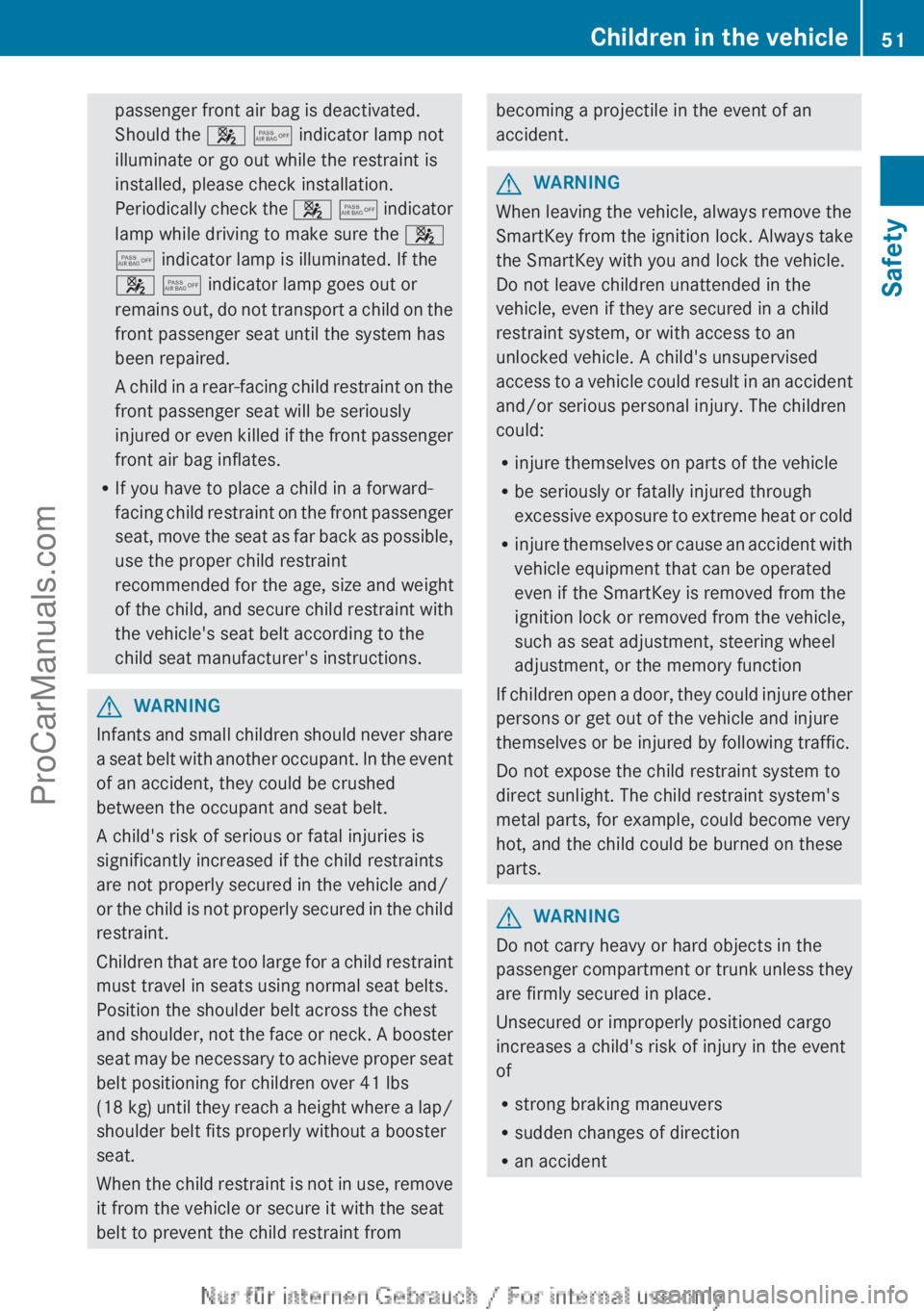
passenger front air bag is deactivated.
Should the 4 5 indicator lamp not
illuminate or go out while the restraint is
installed, please check installation.
Periodically check
the 4
5 indicator
lamp while driving to make sure the 4
5 indicator lamp is illuminated. If the
4 5 indicator lamp goes out or
remains out, do not transport a child on the
front passenger seat until the system has
been repaired.
A child in a rear-facing child restraint on the
front passenger seat will be seriously
injured or even killed if the front passenger
front air bag inflates.
R If you have to place a child in a forward-
facing child restraint on the front passenger
seat, move the seat as far back as possible,
use the proper child restraint
recommended for the age, size and weight
of the child, and secure child restraint with
the vehicle's seat belt according to the
child seat manufacturer's instructions. G
WARNING
Infants and small children should never share
a seat belt
with another occupant. In the event
of an accident, they could be crushed
between the occupant and seat belt.
A child's risk of serious or fatal injuries is
significantly increased if the child restraints
are not properly secured in the vehicle and/
or the child is not properly secured in the child
restraint.
Children that are too large for a child restraint
must travel in seats using normal seat belts.
Position the shoulder belt across the chest
and shoulder, not the face or neck. A booster
seat may be necessary to achieve proper seat
belt positioning for children over 41 lbs
(18 kg) until they reach a height where a lap/
shoulder belt fits properly without a booster
seat.
When the child restraint is not in use, remove
it from the vehicle or secure it with the seat
belt to prevent the child restraint from becoming a projectile in the event of an
accident.
G
WARNING
When leaving the vehicle, always remove the
SmartKey from the ignition lock. Always take
the SmartKey with you and lock the vehicle.
Do not leave children unattended in the
vehicle, even if they are secured in a child
restraint system, or with access to an
unlocked vehicle. A child's unsupervised
access to a
vehicle could result in an accident
and/or serious personal injury. The children
could:
R injure themselves on parts of the vehicle
R be seriously or fatally injured through
excessive exposure to extreme heat or cold
R injure themselves or cause an accident with
vehicle equipment that can be operated
even if the SmartKey is removed from the
ignition lock or removed from the vehicle,
such as seat adjustment, steering wheel
adjustment, or the memory function
If children open a door, they could injure other
persons or get out of the vehicle and injure
themselves or be injured by following traffic.
Do not expose the child restraint system to
direct sunlight. The child restraint system's
metal parts, for example, could become very
hot, and the child could be burned on these
parts. G
WARNING
Do not carry heavy or hard objects in the
passenger compartment or
trunk unless they
are firmly secured in place.
Unsecured or improperly positioned cargo
increases a child's risk of injury in the event
of
R strong braking maneuvers
R sudden changes of direction
R an accident Children in the vehicle
51
Safety Z
ProCarManuals.com
Page 54 of 340
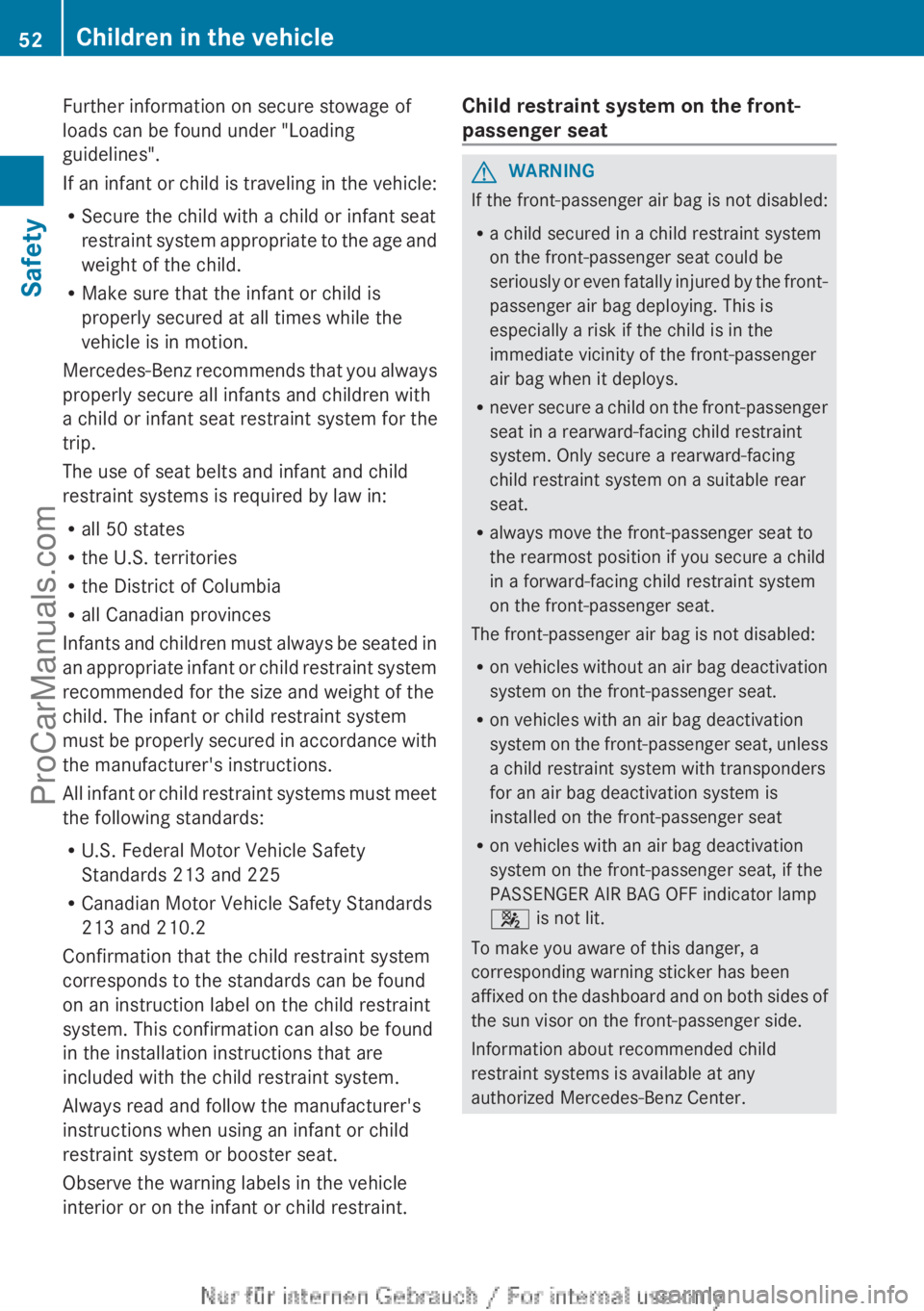
Further information on secure stowage of
loads can be found under "Loading
guidelines".
If an
infant
or child is traveling in the vehicle:
R Secure the child with a child or infant seat
restraint system appropriate to the age and
weight of the child.
R Make sure that the infant or child is
properly secured at all times while the
vehicle is in motion.
Mercedes-Benz recommends that you always
properly secure all infants and children with
a child or infant seat restraint system for the
trip.
The use of seat belts and infant and child
restraint systems is required by law in:
R all 50 states
R the U.S. territories
R the District of Columbia
R all Canadian provinces
Infants and children must always be seated in
an appropriate infant or child restraint system
recommended for the size and weight of the
child. The infant or child restraint system
must be properly secured in accordance with
the manufacturer's instructions.
All infant or child restraint systems must meet
the following standards:
R U.S. Federal Motor Vehicle Safety
Standards 213 and 225
R Canadian Motor Vehicle Safety Standards
213 and 210.2
Confirmation that the child restraint system
corresponds to the standards can be found
on an instruction label on the child restraint
system. This confirmation can also be found
in the installation instructions that are
included with the child restraint system.
Always read and follow the manufacturer's
instructions when using an infant or child
restraint system or booster seat.
Observe the warning labels in the vehicle
interior or on the infant or child restraint. Child restraint system on the front-
passenger seat G
WARNING
If the front-passenger air bag is not disabled:
R a child secured in a child restraint system
on the front-passenger seat could be
seriously or even
fatally injured by the front-
passenger air bag deploying. This is
especially a risk if the child is in the
immediate vicinity of the front-passenger
air bag when it deploys.
R never secure a child on the front-passenger
seat in a rearward-facing child restraint
system. Only secure a rearward-facing
child restraint system on a suitable rear
seat.
R always move the front-passenger seat to
the rearmost position if you secure a child
in a forward-facing child restraint system
on the front-passenger seat.
The front-passenger air bag is not disabled:
R on vehicles without an air bag deactivation
system on the front-passenger seat.
R on vehicles with an air bag deactivation
system on the front-passenger seat, unless
a child restraint system with transponders
for an air bag deactivation system is
installed on the front-passenger seat
R on vehicles with an air bag deactivation
system on the front-passenger seat, if the
PASSENGER AIR BAG OFF indicator lamp
4 is not lit.
To make you aware of this danger, a
corresponding warning sticker has been
affixed on the dashboard and on both sides of
the sun visor on the front-passenger side.
Information about recommended child
restraint systems is available at any
authorized Mercedes-Benz Center. 52
Children in the vehicle
Safety
ProCarManuals.com
Page 55 of 340

Warning notice on the front-passenger sun visor
Warning symbol for a rearward-facing child
restraint system
Do not use a rearward-facing child restraint
system on a seat that is protected by an air
bag installed in front of it.
Air bag deactivation system on the
front-passenger seat
G
WARNING
If the 4 PASSENGER AIRBAG OFF
indicator lamp does not light up when the
child restraint system is installed, the front-
passenger air bag has not been disabled. If
the front-passenger air
bag deploys, the child
could be seriously or even fatally injured.
Proceed as follows:
R do not use a rearward-facing child restraint
system on the front-passenger seat.
R install a rearward-facing child restraint
system on a suitable rear seat.
or R
only use a forward-facing child restraint
system on the front-passenger seat and
move the front-passenger seat to the
rearmost position.
R have the air bag deactivation system
checked at a
qualified specialist workshop.
To ensure that the air bag deactivation system
on the front-passenger seat functions/
communicates correctly, never place objects,
e.g. a cushion, under the child restraint
system. The entire base of the child restraint
system must always rest on the seat cushion.
An incorrectly installed child restraint system
cannot perform its intended protective
function in the event of an accident, and could
lead to injuries. G
WARNING
Do not place electronic devices on the front-
passenger seat, e.g.:
R laptops, when switched on
R mobile phones
R cards with transponders,
e.g. ski passes or
access cards
Signals from electronic equipment can cause
interference in the sensor system of the air
bag deactivation system. This can lead to a
system malfunction. This may cause the
4 PASSENGER AIR BAG OFF indicator
lamp to light up even if no child seat with a
transponder for an air bag deactivation
system is installed. The front-passenger air
bag would not then deploy during an accident.
It is also possible that the 6 SRS warning
lamp lights up and/or the 4 PASSENGER
AIR BAG OFF indicator lamp does not light up
briefly when you turn the key in the ignition
lock to position 2. Children in the vehicle
53
Safety Z
ProCarManuals.com
Page 56 of 340

If the front-passenger seat of your vehicle
does not
have
an air bag deactivation system,
this is indicated by a special sticker. The
sticker is affixed to the side of the dashboard
on the front-passenger side. The sticker is
visible when you open the front-passenger
door.
Vehicles without an air bag deactivation
system on the front-passenger seat: if you
turn the SmartKey to position 2 in the ignition
lock, the 45 indicator lamp lights up
briefly but has no function. It does not
indicate that there is an air bag deactivation
system on the front-passenger seat. The sensor system for the air bag deactivation
system detects
whether
a special Mercedes-
Benz child seat with a transponder for the air
bag deactivation system has been installed.
In this case, 45 indicator lamp :
lights up. The front-passenger front air bag is
deactivated: i
If the front-passenger front air bag is
disabled by the air bag deactivation
system, the following remain enabled on
the front-passenger side:
R the side impact air bag
R the window curtain air bag
R the Emergency Tensioning Device
LATCH-type (ISOFIX) child
seat anchors
in the rear G
WARNING
Children that are too large for a child restraint
must travel in seats using normal seat belts.
Position the shoulder belt across the chest
and shoulder, not the face or neck.
A booster seat may be necessary to achieve
proper seat belt positioning for children over
41 lbs (18 kg
) until they reach a height where
a normal shoulder/lap belt fit properly
without a booster.
Install the child seat according to
manufacturer's instructions.
The child seat must be firmly attached to both
anchors.
An incorrectly installed child restraint system
could come loose during an accident and
seriously or even fatally injure the child.
Damaged or impact damaged child seats or
child seat mountings must be replaced.
! When installing the LATCH-type (ISOFIX)
child restraint system, make sure that the
seat belt for the center seat does not get
trapped. Otherwise, the seat belt could be
damaged. 54
Children in the vehicle
Safety
ProCarManuals.com
Page 57 of 340
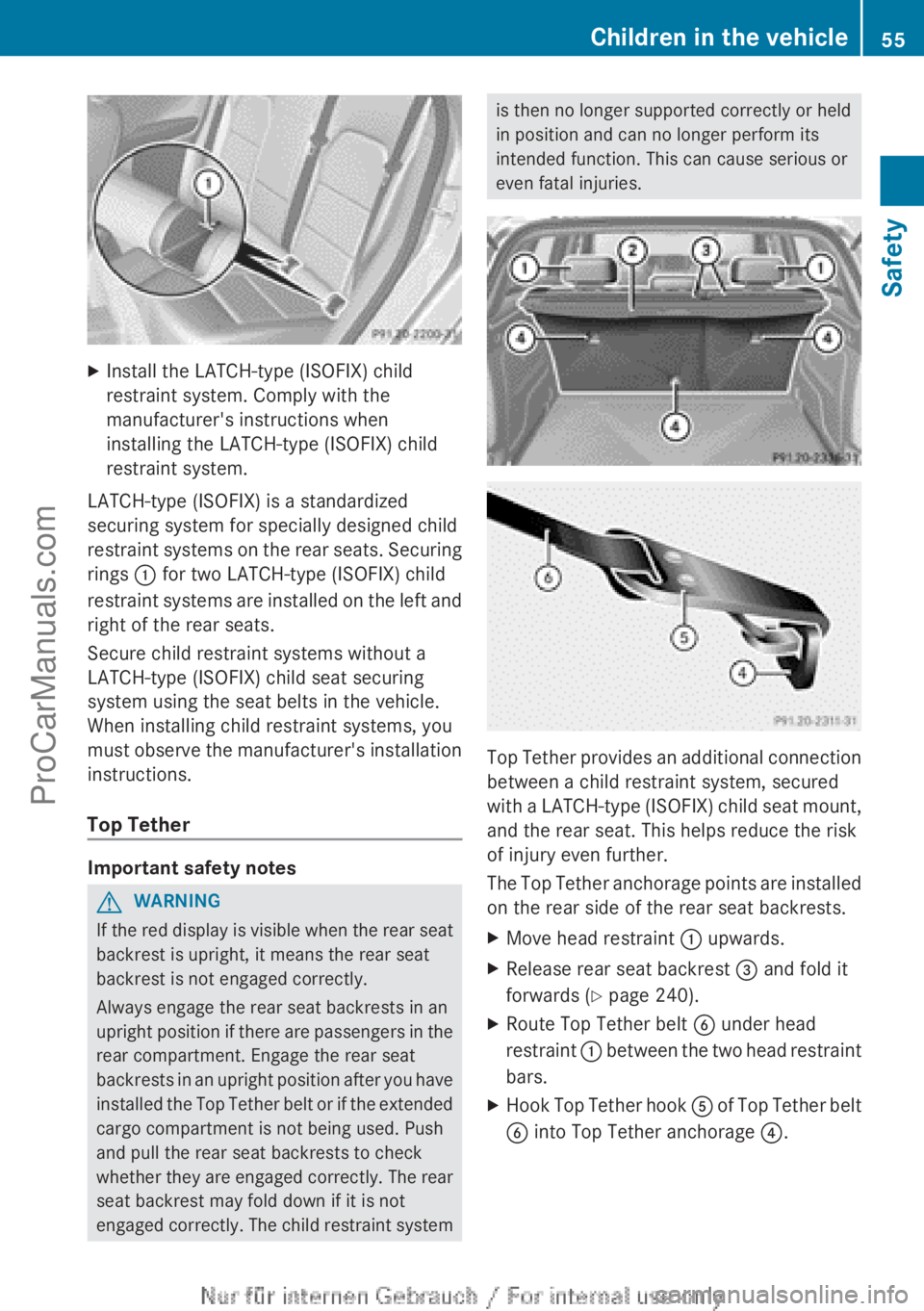
X
Install the LATCH-type (ISOFIX) child
restraint system. Comply with the
manufacturer's instructions when
installing the LATCH-type (ISOFIX) child
restraint system.
LATCH-type (ISOFIX) is a standardized
securing system for specially designed child
restraint systems on
the rear seats. Securing
rings : for two LATCH-type (ISOFIX) child
restraint systems are installed on the left and
right of the rear seats.
Secure child restraint systems without a
LATCH-type (ISOFIX) child seat securing
system using the seat belts in the vehicle.
When installing child restraint systems, you
must observe the manufacturer's installation
instructions.
Top Tether Important safety notes
G
WARNING
If the red display is visible when the rear seat
backrest is upright, it means the rear seat
backrest is not engaged correctly.
Always engage the rear seat backrests in an
upright position if
there are passengers in the
rear compartment. Engage the rear seat
backrests in an upright position after you have
installed the Top Tether belt or if the extended
cargo compartment is not being used. Push
and pull the rear seat backrests to check
whether they are engaged correctly. The rear
seat backrest may fold down if it is not
engaged correctly. The child restraint system is then no longer supported correctly or held
in position and can no longer perform its
intended function. This can cause serious or
even fatal injuries.
Top Tether provides an additional connection
between a child restraint system, secured
with a
LATCH-type
(ISOFIX) child seat mount,
and the rear seat. This helps reduce the risk
of injury even further.
The Top Tether anchorage points are installed
on the rear side of the rear seat backrests.
X Move head restraint : upwards.
X Release rear seat backrest = and fold it
forwards ( Y page 240).
X Route Top Tether belt B under head
restraint : between the
two head restraint
bars.
X Hook Top Tether hook A of
Top
Tether belt
B into Top Tether anchorage ?. Children in the vehicle
55
Safety Z
ProCarManuals.com
Page 58 of 340
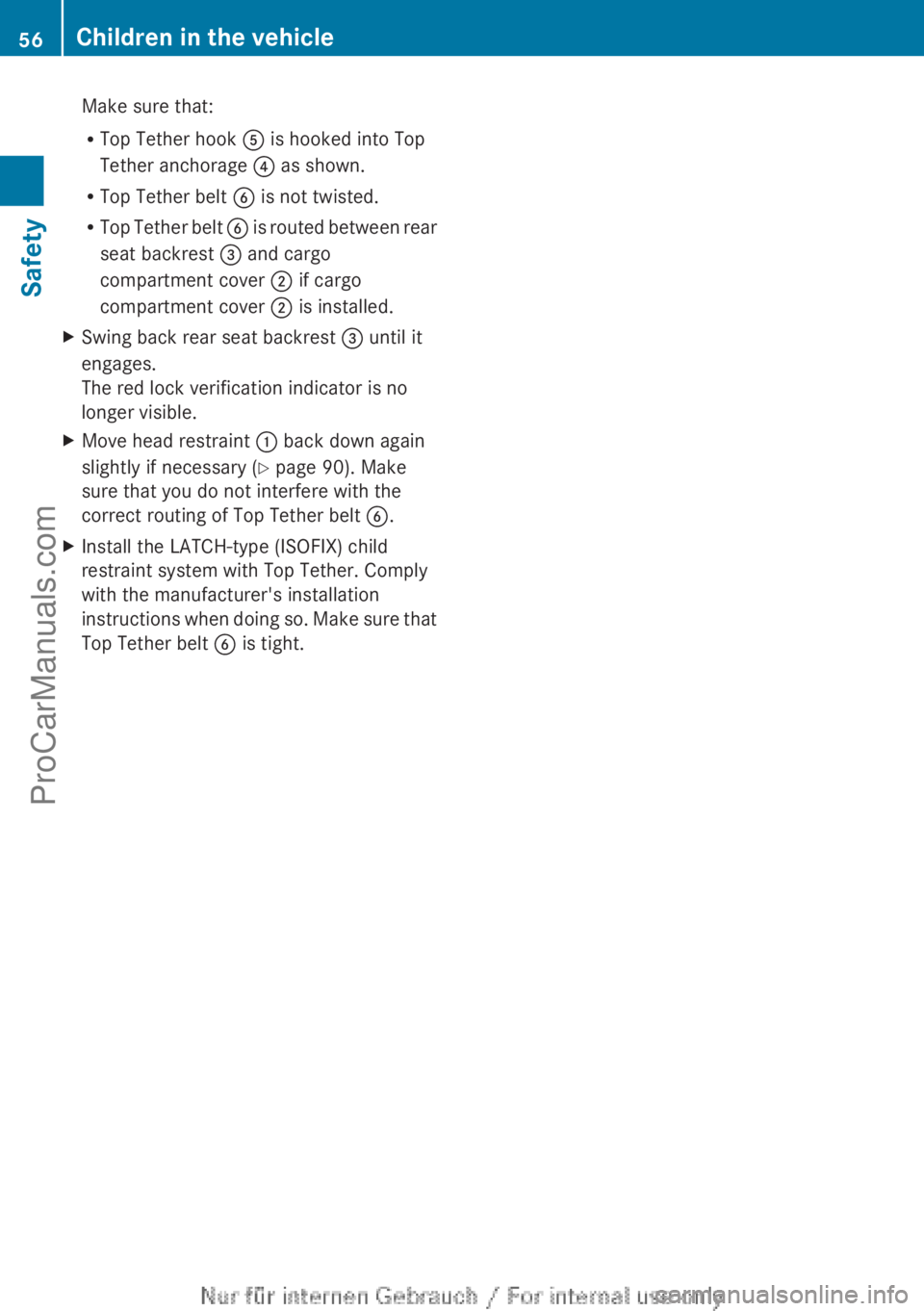
Make sure that:
R
Top Tether hook A is hooked into Top
Tether anchorage ? as shown.
R Top Tether belt B is not twisted.
R Top Tether
belt B
is routed between rear
seat backrest = and cargo
compartment cover ; if cargo
compartment cover ; is installed.
X Swing back rear seat backrest = until it
engages.
The red lock verification indicator is no
longer visible.
X Move head restraint : back down again
slightly if necessary (
Y page 90). Make
sure that you do not interfere with the
correct routing of Top Tether belt B
.
X Install the LATCH-type (ISOFIX) child
restraint system with Top Tether. Comply
with the manufacturer's installation
instructions when
doing
so. Make sure that
Top Tether belt B is tight. 56
Children in the vehicle
Safety
ProCarManuals.com
Page 59 of 340
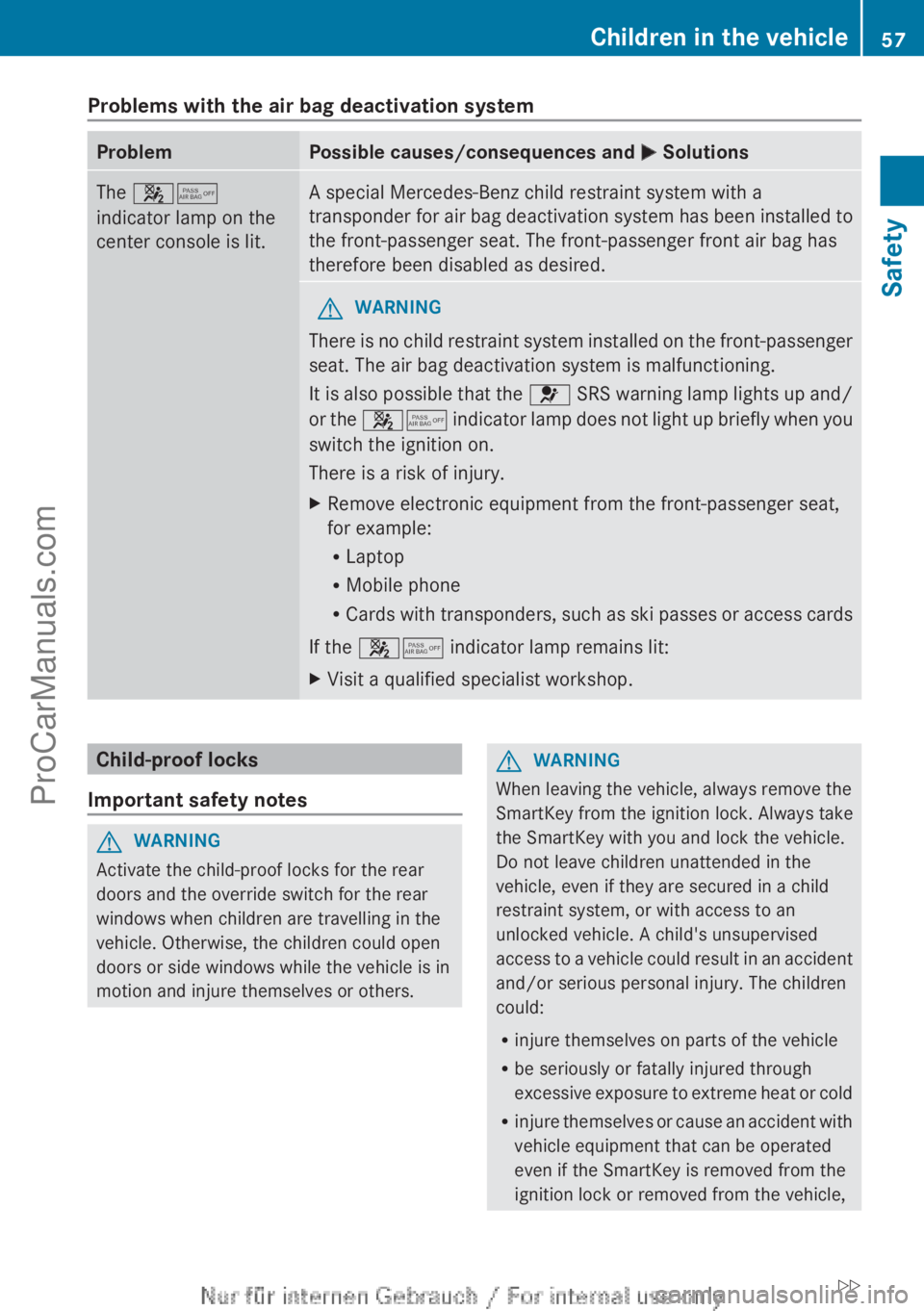
Problems with the air bag deactivation system
Problem Possible causes/consequences and
M SolutionsThe 45
indicator lamp on the
center console is lit. A special Mercedes-Benz child restraint system with a
transponder for
air
bag deactivation system has been installed to
the front-passenger seat. The front-passenger front air bag has
therefore been disabled as desired. G
WARNING
There is no child restraint system installed on the front-passenger
seat. The air bag deactivation system is malfunctioning.
It is also
possible that the 6 SRS warning lamp lights up and/
or the 45 indicator lamp does not light up briefly when you
switch the ignition on.
There is a risk of injury.
X Remove electronic equipment from the front-passenger seat,
for example:
R
Laptop
R Mobile phone
R Cards with transponders,
such as ski passes or access cards
If the 45 indicator lamp remains lit:
X Visit a qualified specialist workshop. Child-proof locks
Important safety notes G
WARNING
Activate the child-proof locks for the rear
doors and the override switch for the rear
windows when children are travelling in the
vehicle. Otherwise, the children could open
doors or side windows while the vehicle is in
motion and injure themselves or others. G
WARNING
When leaving the vehicle, always remove the
SmartKey from the ignition lock. Always take
the SmartKey with you and lock the vehicle.
Do not leave children unattended in the
vehicle, even if they are secured in a child
restraint system, or with access to an
unlocked vehicle. A child's unsupervised
access to a
vehicle could result in an accident
and/or serious personal injury. The children
could:
R injure themselves on parts of the vehicle
R be seriously or fatally injured through
excessive exposure to extreme heat or cold
R injure themselves or cause an accident with
vehicle equipment that can be operated
even if the SmartKey is removed from the
ignition lock or removed from the vehicle, Children in the vehicle
57
Safety
ZProCarManuals.com
Page 60 of 340
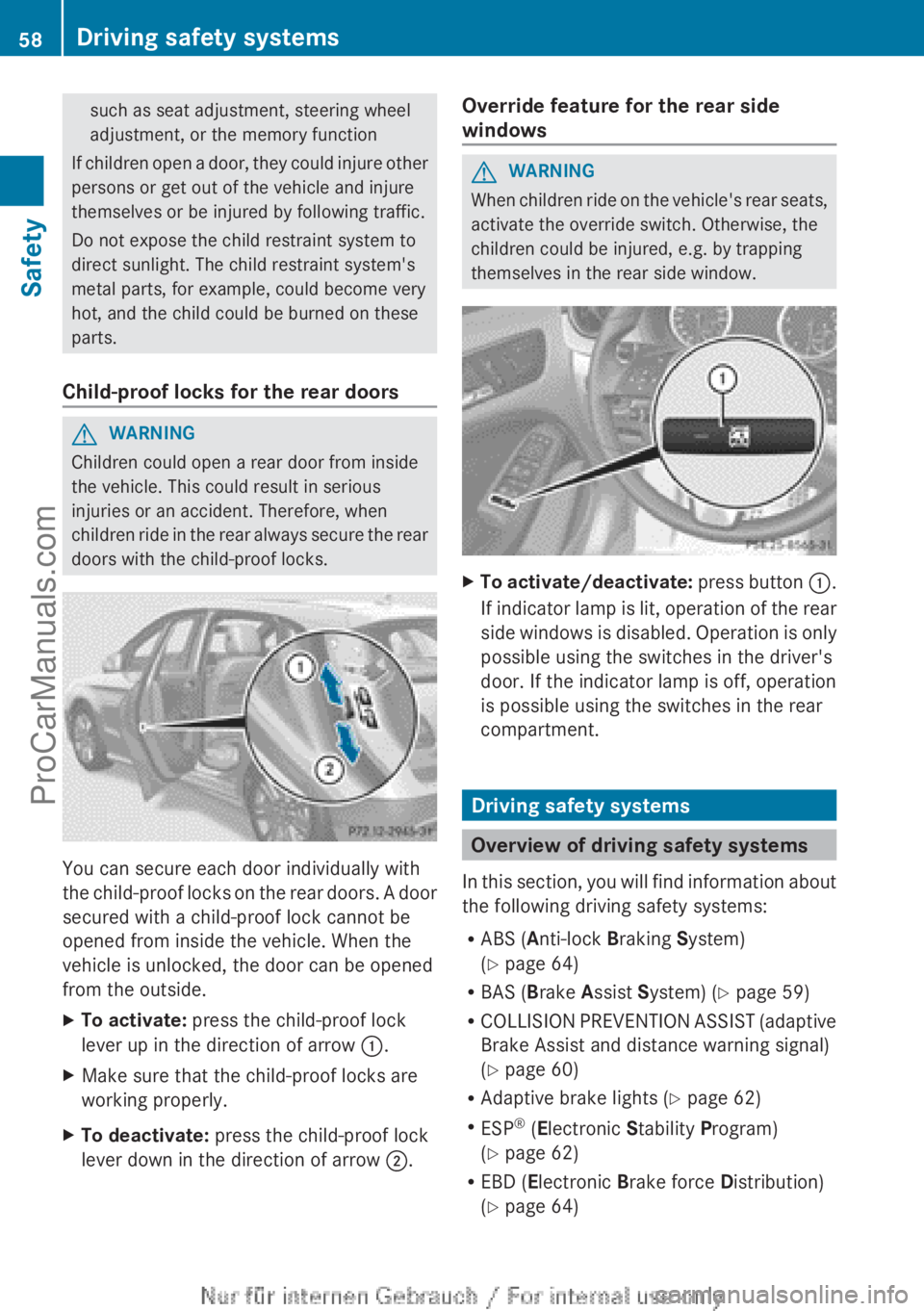
such as seat adjustment, steering wheel
adjustment, or the memory function
If children open
a door, they could injure other
persons or get out of the vehicle and injure
themselves or be injured by following traffic.
Do not expose the child restraint system to
direct sunlight. The child restraint system's
metal parts, for example, could become very
hot, and the child could be burned on these
parts.
Child-proof locks for the rear doors G
WARNING
Children could open a rear door from inside
the vehicle. This could result in serious
injuries or an accident. Therefore, when
children ride in
the rear always secure the rear
doors with the child-proof locks. You can secure each door individually with
the child-proof
locks
on the rear doors. A door
secured with a child-proof lock cannot be
opened from inside the vehicle. When the
vehicle is unlocked, the door can be opened
from the outside.
X To activate: press the child-proof lock
lever up in the direction of arrow :.
X Make sure that the child-proof locks are
working properly.
X To deactivate: press the child-proof lock
lever down in the direction of arrow ;. Override feature for the rear side
windows G
WARNING
When children ride on the vehicle's rear seats,
activate the override switch. Otherwise, the
children could be injured, e.g. by trapping
themselves in the rear side window. X
To activate/deactivate: press button :.
If
indicator lamp is lit, operation of the rear
side windows is disabled. Operation is only
possible using the switches in the driver's
door. If the indicator lamp is off, operation
is possible using the switches in the rear
compartment. Driving safety systems
Overview of driving safety systems
In this section,
you will find information about
the following driving safety systems:
R ABS ( Anti-lock Braking System)
(Y page 64)
R BAS ( Brake Assist System) ( Y page 59)
R COLLISION PREVENTION ASSIST (adaptive
Brake Assist and distance warning signal)
(Y page 60)
R Adaptive brake lights ( Y page 62)
R ESP ®
(Electronic Stability Program)
(Y page 62)
R EBD ( Electronic Brake force Distribution)
(Y page 64) 58
Driving safety systems
Safety
ProCarManuals.com